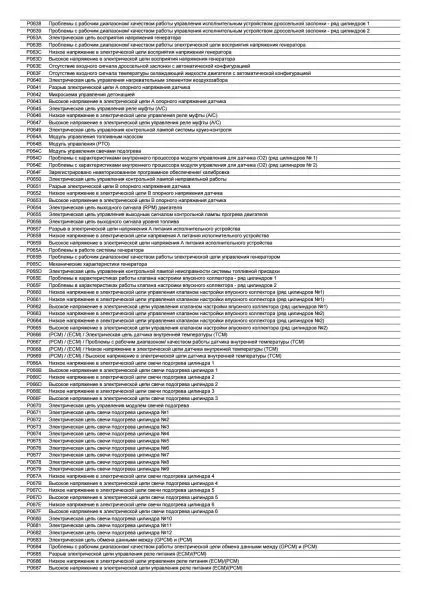
P065C Mechanical characteristics of the generator
Content
- P065C Mechanical characteristics of the generator
- OBD-II DTC Datasheet
- What does this mean?
- What is the severity of this DTC?
- What are some of the symptoms of the code?
- What are some of the common causes for the code?
- What are some steps to troubleshoot the P065C?
- Related DTC discussions
- Need more help with a P065C code?
P065C Mechanical characteristics of the generator
OBD-II DTC Datasheet
Mechanical characteristics of the generator
What does this mean?
This is a generic Diagnostic Trouble Code (DTC) applicable to many OBD-II vehicles (1996 and newer). This may include, but is not limited to, Mazda, Nissan, Land Rover, Chrysler, Ford, Dodge, GMC, etc. Despite the general nature, the exact repair steps may vary depending on the model year, make, model and configuration. transmissions.
A stored code P065C means the powertrain control module (PCM) or one of the other associated controllers has detected a low output condition in the generator system.
In some cases, an alternator is called a generator, but more often this type of code is used in a hybrid or electric vehicle that generates constant electrical power from a generator. The generator can be driven by the engine or any of the drive wheels.
The PCM monitors the generator output voltage and amperage at various speed and load levels and calculates voltage requirements accordingly. In addition to monitoring the generator output (performance), the PCM is also responsible for supplying a signal that turns the generator lamp on in the event of a low output.
If a problem is detected while monitoring generator performance, a P065C code will be stored and a malfunction indicator lamp (MIL) may illuminate.
Example of an alternator (generator): 
What is the severity of this DTC?
The P065C code must be classified as serious as it can result in low battery levels and / or inability to start.
What are some of the symptoms of the code?
Symptoms of a P065C trouble code may include:
- Delayed start or not
- Electrical accessories may not work
- Engine control problems
What are some of the common causes for the code?
Reasons for this code may include:
- Defective generator
- Bad fuse, relay, or fuse
- Open or short circuit in the circuit between the PCM and the generator
- PCM programming error
- Faulty controller or PCM
What are some steps to troubleshoot the P065C?
The battery must be fully charged and the alternator must be operating at an acceptable level before attempting to diagnose a P065C.
Consult your vehicle information source for technical service bulletins (TSBs) that reproduce the stored code, vehicle (year, make, model and engine) and symptoms detected. If you find an appropriate TSB, it can provide useful diagnostic information.
A diagnostic scanner and a digital volt / ohmmeter are required to accurately diagnose the P065C code. You will also need a reliable source of vehicle information.
Start by connecting the scanner to the vehicle's diagnostic port and retrieving all stored codes and freeze frame data. You will want to write this information down just in case the code turns out to be intermittent.
After recording all relevant information, clear the codes and test drive the vehicle (if possible) until the code is cleared or the PCM enters ready mode.
If the PCM goes into ready mode, the code will be intermittent and even more difficult to diagnose. The condition that led to the persistence of P065C may need to worsen before an accurate diagnosis can be made. On the other hand, if the code cannot be cleared and the symptoms of handling do not appear, the vehicle can be driven normally.
If P065C resets immediately, visually inspect the wiring and connectors associated with the system. Belts that have been broken or unplugged should be repaired or replaced as needed.
If the wiring and connectors are OK, use your vehicle information source to obtain related wiring diagrams, connector face views, connector pinout diagrams, and diagnostic block diagrams.
With the correct information, check all fuses and relays in the system to make sure the generator is energized.
If there is no generator supply voltage, trace the appropriate circuit to the fuse or relay from which it comes. Repair or replace defective fuses, relays, or fuses as necessary. In some cases, the generator supply voltage is routed through the PCM. You can use wiring diagrams and other vehicle-specific information to help diagnose alternator faults.
If generator supply voltage is present, use the DVOM to test the generator output performance at the appropriate terminal on the generator connector. If an appropriate generator output voltage level is not detected, suspect that the generator is faulty.
If the alternator is charging according to specifications, check the voltage level at the appropriate pin on the PCM connector. If the voltage on the PCM connector is the same as on the alternator, suspect the PCM is defective or there is a programming error.
If the voltage level at the PCM connector differs (more than 10 percent) from what is detected at the alternator connector, suspect a short or open circuit between the two.
- Generator fuses should be checked with a loaded circuit to avoid misdiagnosis.
Related DTC discussions
- There are currently no related topics in our forums. Post a new topic on the forum now.
Need more help with a P065C code?
If you still need help with DTC P065C, post a question in the comments below this article.
NOTE. This information is provided for informational purposes only. It is not intended to be used as a repair recommendation and we are not responsible for any action you take on any vehicle. All information on this site is protected by copyright.

2 comment
anonym
What does error code p 0562 mean?
Jozsef Petó
What does error code p0562 mean?